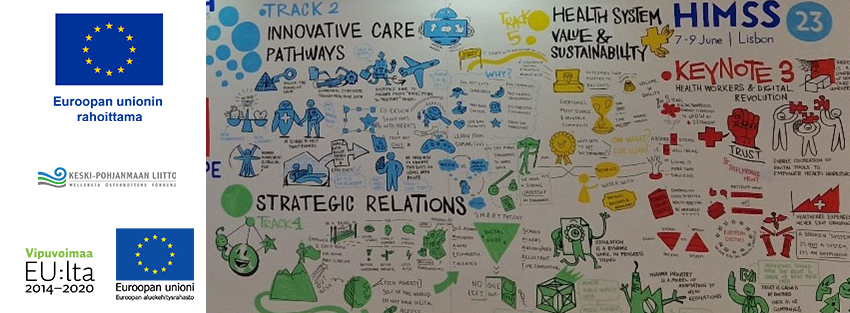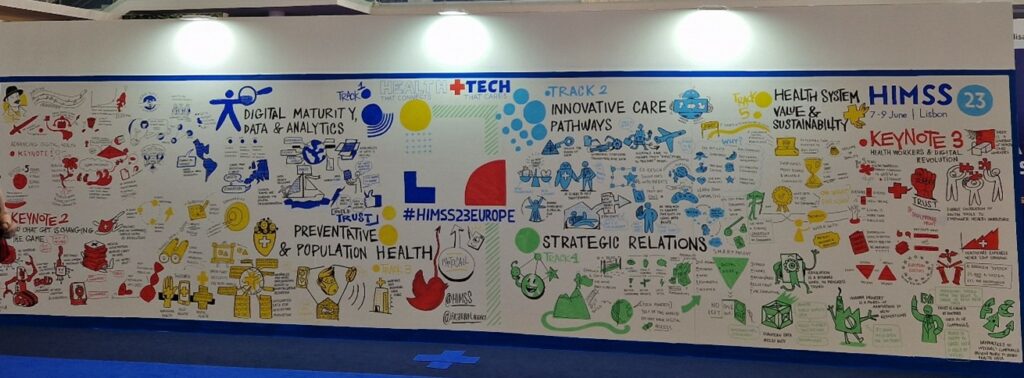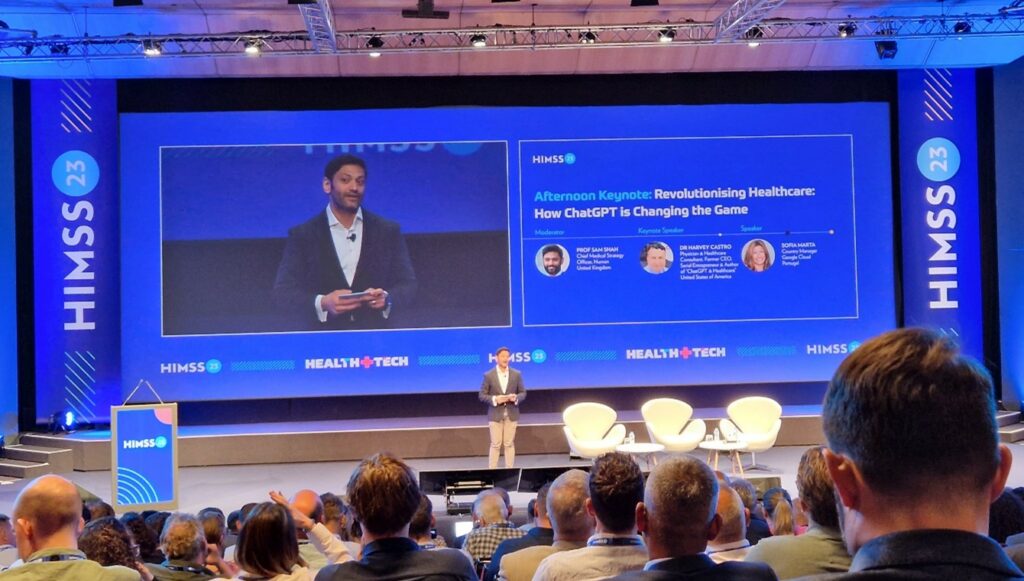Heidi Hintsala
Hanna-Mari Pesonen

HIMSS23 European Health Conference & Exhibition event organized by the Healthcare Information and Management Systems Society HIMSS brought together European health technology researchers and developers in Lisbon on June 7-9, 2023. Experts from Centria’s HealthTech research group participated in the event to learn about the latest health technology trends, European cooperation and strategies, and to hear examples of best practices for the development and utilization of health technology. In this article, we describe some of the key perspectives and development needs that were presented at the conference.
Can we provide health for all with health technology solutions?
The main themes of the HIMSS23 conference were Digital maturity, Data and analytics, Preventative and population health, Innovative care pathways, Workforce crisis solutions, and Health system value and sustainability (Picture 1).

The conference began with keynote speech and panel discussion aiming no more than fixing global health, with a title: “Before Colonising Mars, How Do We Fix Global Health”. The World Health Organization’s (WHO) goal to provide equal health for all (World Health Organization 2023) and opportunities provided by new technologies and digitalization, as well as challenges to reach the goal were discussed. Centria’s own health and social care technology activities in Ostrobothnia in Finland aim locally to reach different groups as equally as possible.
We have collaborated with private and public health care providers, third sector, with children, adults and older adults, with people having disabilities, mental health challenges, chronic diseases or neurological rehabilitation needs, and people residing or working in central as well as peripheral parts of Ostrobothnia (Kaartinen, Kamau & Hintsala 2022). From a global perspective, we have worked in a privileged area in northern Europe, with access to the newest technological innovations and high-quality health care. When designing our fore coming international projects, we should consider the possibilities to increase knowledge of relevant health and wellness technologies in third countries and other areas struggling with higher burden of disease and limited access to technological solutions.
How AI tools could be used in health care?
The hot topic of today, artificial intelligence (AI) and the new AI tool everyone is talking about, Chat-GPT was presented and discussed in the event on health care perspective (Picture 2). It was suggested to provide relevant info for patients before visiting the physician to better know what to ask and look for during the medical visit. It was also brought out that Chat-GPT could follow the discussion during the visit to assist when needed, automatically create notes and optimize the follow-up procedures. Afterwards, Chat-GPT could provide discharge instructions and self-care recommendations by combining the info obtained during the medical visit with official health guidelines. At the moment, these are just futuristic discussions, and the bad sides of the new tool were also discussed in the panel. Chat-GPT does not provide the needed information security for medical purposes and its ability to obey official guidelines and avoid dis- and misinformation can be questioned. However, when developed and adjusted to medical needs in the future, AI chat tools may assist health care professionals to a keep on the large amount of new information provided by ongoing medical research as well as to support their customers with the suggested procedures.

Could health technology give tools to promote population health and personalized care?
The conference discussed technology application and development from the perspectives of patients and health care personnel. Technology, such as self-measurements, remote access to health data and online appointments with health care personnel are used to support the shift to more personalized and interactive health care. This kind of person-enabled care also considers patients as equal partners with health care professionals instead of them being objects of treatment and diagnoses. The conference speakers strongly highlighted that the development and use of technology should bear in mind the patients for whom the development work is being carried out. The goal of health and social care is to promote health and well-being for the population by using the limited resources efficiently. The focus of the value-based health care is on the well-being impacts that are relevant to the patient (Teisberg, Wallace & O’Hara 2020). Thus, technology should be used for improving patient health outcomes and to reduce health inequalities.
Engaging patients in product development means giving voice to those whom the technology is designed for. By asking the patients “What matters to you?” we can learn to know the technology users and their needs. Most important should be what matters to the patients themselves. This is in line with the person-centered care approach which addresses patients’ values, needs, and preferences in the care process (Grover, Fitzpatrick, Tabassum Azim, Ariza-Vega, Bellwood, Burns, Burton, Fleig, Clemson, Hoppmann, Madden, Price, Langford & Ashe 2022). In Centria we have responded to this need to engage users in the development work in the HIPPA-Remote project (financed by the European Regional Development Fund) by interviewing the older adults and those with disabilities and mental health problems about their daily life, and service needs for better health and wellbeing.
Can we tackle the workforce crisis in health care with health technology solutions?
From a personnel’s perspective, technology can be used to empower the workforce by giving them new means to provide care. Technology has been long aimed to assist in repetitive and physically heavy tasks, and now with fast development in data processing methods more is expected on complex tasks such as support in diagnosis. We are facing a health workforce crisis in Europe and globally which affects negatively not only the population but also the health care workers. Shortage of health care personnel undermines opportunities to provide health services to those who need them. For the health care personnel, it increases workload and stress and can lead to a lack of motivation, burnout and career change. (World Health Organization 2022) Greater use of digital tools in health care service delivery could ease the workload of professionals, for example by reducing manual work processes and tasks. However, it should be noted that it requires improving digital health skills for both the personnel and the patients. This need is partly met by the RoboPop project (funded by the European Social Fund Plus ESF+), launched in September 2023, which aims to develop multidisciplinary expertise in health technology in Central Ostrobothnia, Finland.
Overall, the conference opened prospects for new health technology solutions that can deliver health benefits and well-being to patients and meet the challenges of the work of health care professionals. Finding new development paths takes place through well-coordinated and inclusive cooperation. This is promoted by the COMEA project (funded by the Regional Council of Central Ostrobothnia), in which we aim to develop network cooperation in the development of wellness and health technology in the Central Ostrobothnia region. The COMEA project supports RDI activities, technology companies and social and health care service providers in the region. After the conference, we will be eagerly looking forward to new possibilities that technology enabled care could provide for patients and professionals.
Financed by: HIPPA-Remote project financed by the European Regional Development Fund (EAKR), RoboPop project funded by the European Social Fund Plus ESF+ (ESR+), COMEA project funded by the Regional Council of Central Ostrobothnia (Keski-Pohjanmaan liitto, AKKE).
References
Grover, S., Fitzpatrick, A., Tabassum Azim, F., Ariza-Vega, P. Bellwood, P., Burns, J., Burton, E., Fleig, L., Clemson, L., Hoppmann, C.A., Madden, K.M., Price, M., Langford, D. & Ashe, M.C. 2022. Defining and implementing patient-centered care: An umbrella review. Patient Education and Counseling 105(7), 1679-1688. Available at https://doi.org/10.1016/j.pec.2021.11.004. Accessed 8 September 2023.
Kaartinen, H., Kamau, A. & Hintsala, H. 2022. Centria HealthLabin laitekaruselli tarjoaa helpon tavan kokeilla uutta teknologiaa sosiaali- ja terveydenhuollon palveluntuottajien arjessa. Centria Bulletin. Available at https://centriabulletin.fi/centria-healthlabin-laitekaruselli/. Accessed 29 August 2023.
Teisberg E., Wallace S. & O’Hara S. 2020. Defining and Implementing Value-Based Health Care: A Strategic Framework. Academic Medicine 95(5), 682-685. Available at doi: 10.1097/ACM.0000000000003122. Accessed 8 September 2023.
World Health Organization. 2022. Health and care workforce in Europe: time to act. Copenhagen: WHO Regional Office for Europe; 2022. Licence: CC BY-NC-SA 3.0 IGO. Available at https://www.who.int/europe/publications/i/item/9789289058339. Accessed 8 September 2023.
World Health Organization. 2023. Health equity. Available at https://www.who.int/health-topics/health-equity#tab=tab_1. Accessed 29 August 2023.
Heidi Hintsala
RDI Coordinator, project manager
Centria University of Applied Sciences
Tel. +358 40 185 6259
Hanna-Mari Pesonen
Principal lecturer
Centria University of Applied Sciences
Tel. +358 40 681 0588

